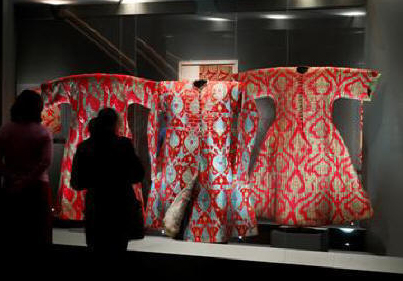Caftans were worn by the Ottoman sultans. The decorations, including the colors, patterns, ribbons, and buttons on the garment, showed the rank of the wearer. Large patterned textiles were used from the 14th to the 17th centuries. In the late 16th and early 17th centuries, decorative patterns in fabrics became smaller and brighter.
In the Ottomans, a caftan was given as a gift by the sultan to reward those who performed important services. When a concession was given to commanders, swords and robes were given as a sign.
The "artistic" gold-thread-embroidered dresses, decorated with margins, worn by rulers or elite people are called caftans. The name and nicknames of the sultan were included in the margins of these dresses. When these dresses, which are called caftan, hilat or tiraz, were given to someone for reward, they were called hilat caftan dressing. This tradition was also present in the Seljuks.
Most of the fabrics were manufactured in Istanbul and Bursa in Turkey. But some textile products Venice, Genoa, Persia (Iran), came from far away as India and even China. Kaftans velvet, aba, crepe (a type of crepe with silk warp and cotton weft), reed, karma (a heavy silk brocade), travel, diba Hatayi, kutnu, kemha, seraser silk warp and brocade fabric with gold or silver metallic thread wefts), serenk, zerbaft and taffeta. The favorite colors are indigo blue, kermes red, violet or "baked quince".
The caftan or robe gown, originating from Asia, is a type of tunic and has been worn in various cultures around the world for thousands of years. The caftan used by many Middle Eastern ethnic groups is originally from ancient Mesopotamia (present-day Iraq). It can be made of wool, cashmere, silk or cotton and can be worn with a sash. Envoys and other important guests were given detailed and carefully designed clothing at Topkapi Palace, which was popular during the Ottoman Empire period. Kaftan varieties have been inherited by cultures in the Middle East and Asia.The caftan is often worn as a coat or top dressing with long sleeves and extending to the ankles. It is worn as a light, loose clothing in regions with hot climates. In some cultures, the caftan has been used as a royal symbol.
During the Islamic golden age of the Abbasid era, cosmopolitan culture spread to Chinese emperors, Anglo-Saxon coins as well as Constantinople (today's Istanbul).
The caftan is inscribed on the intangible cultural heritage of humanity as a costume.
Kaftan is also accepted as a historical document today.





